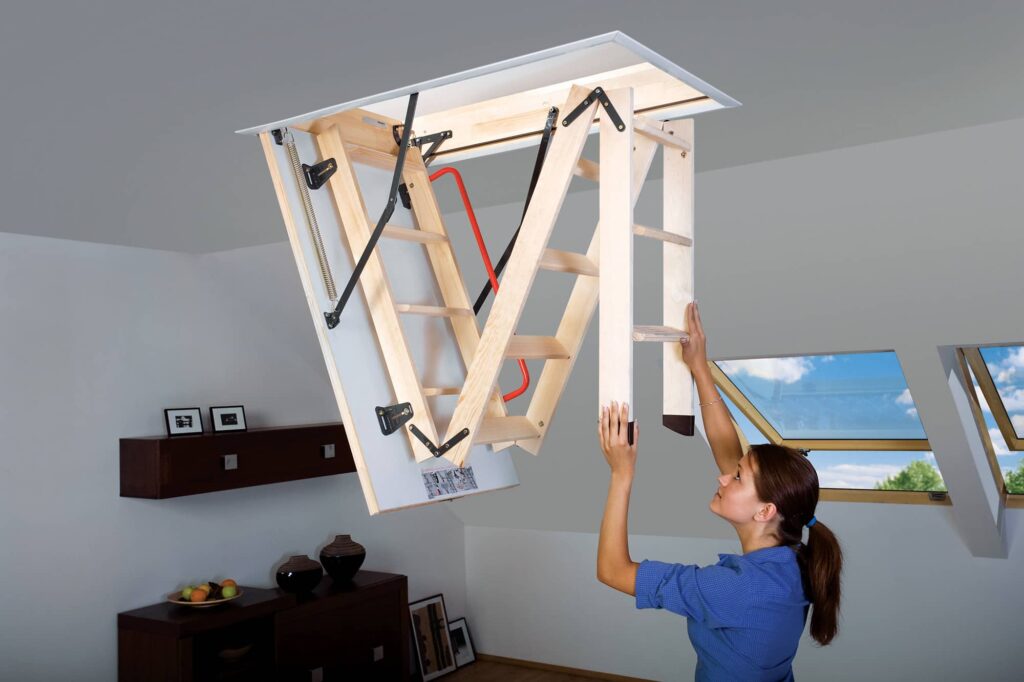Installing an attic ladder involves a number of engineering considerations to ensure safety, functionality, and structural integrity. Here are some key engineering aspects involved in the installation process:
- Structural Analysis: Before installation, it’s crucial to assess the structural integrity of the ceiling and attic floor. The engineer or installer needs to determine if the existing structure can support the added weight and stress of the ladder and the person using it.
- Load-Bearing Capacity: Attic ladders come with specified weight limits. Engineers need to ensure that the ladder can safely support the intended load, including the weight of the person using it and any additional items they might carry into the attic.
- Materials Selection: The materials used in the construction of the attic ladder play a significant role. Engineers must select materials that are both lightweight and strong, ensuring the ladder is sturdy yet doesn’t place excessive strain on the ceiling structure.
- Hinge and Pivot Design: Attic ladders typically feature hinges and pivots to facilitate folding and unfolding. The engineering of these components is critical for smooth operation, durability, and safety. Engineers need to design these elements to withstand repeated use without compromising stability.
- Safety Features: Engineers consider various safety features, such as handrails, non-slip steps, and a secure locking mechanism. These features are designed to prevent accidents and enhance user safety during both ascent and descent.
- Installation Mechanism: The engineering of the installation mechanism is essential for the ease of installation. Attic ladders often come with detailed instructions, and the engineering focuses on making the process straightforward for both professional installers and homeowners attempting a DIY installation.
- Insulation Considerations: Attic ladders should not compromise the insulation of the home. Engineers may design features to minimize heat loss or gain through the attic access point, ensuring energy efficiency.
- Space Utilization: The design of the ladder and its installation mechanism should maximize space utilization. Engineers consider how the ladder can fold and fit into the ceiling opening without encroaching on the living space below.
- Code Compliance: Engineers must ensure that the attic ladder installation adheres to building codes and standards. This involves understanding local regulations related to structural modifications and access points.
- User Experience: The overall engineering of the attic ladder considers the user experience, making sure that the ladder is easy to operate, stable, and safe for users of various ages and physical abilities.
The engineering involved in attic ladder installation is multifaceted, addressing structural, mechanical, and safety aspects to provide a reliable and user-friendly access solution to the attic space. The Attic Group will offer you all the engineering and installation services you need to ensure your Attic Ladder is most suitable for your needs. Don’t fall for a cheap ladder in your expensive home.
Create Your Own Attic Retreat Today
Creating an attic bedroom, workspace or retreat is an excellent way to optimise your unused roof space for a comfortable and relaxing living space. By taking these ideas into consideration, you can transform your attic into an inviting retreat. Whether you just need the extra space or would like to bring some extra value to your property, an attic bedroom is a worthwhile investment. At the Attic Group, our team of attic conversion experts have helped people maximise their home’s potential for over 45 years. We take care of everything from design to construction. Get in touch with us today for a free appraisal.





